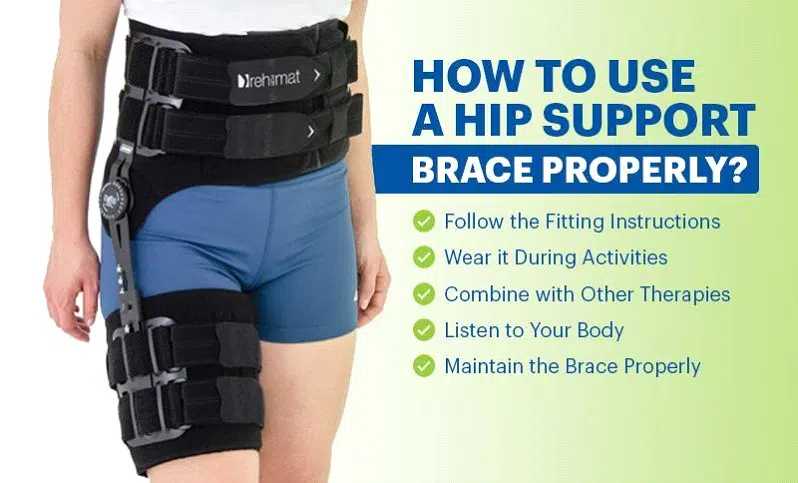Hip pain can be a significant impediment to enjoying daily activities and a full, active lifestyle. Whether due to injury, surgery, arthritis, or other conditions, managing hip pain is crucial for maintaining mobility and quality of life. One often-recommended solution by healthcare professionals is the use of a hip support brace. This article delves into these braces’ numerous benefits and how they can become a cornerstone in managing hip discomfort.
Understanding Hip Pain
Before exploring the benefits of a hip support brace, it’s vital to understand the complexity of hip pain. The hip joint bears a considerable amount of the body’s weight while providing a wide range of motion, making it susceptible to wear and tear, inflammation, and injury. Conditions like osteoarthritis, hip bursitis, and tendonitis, along with post-operative recovery, can all benefit from the correct use of a hip brace.
The Functionality of Hip Support Braces
A hip support brace is designed to offer support and stability to the hip joint and the surrounding muscles. By doing so, it can alleviate pain, distribute weight more evenly, and prevent harmful movements that might exacerbate an injury or condition. Braces can vary in design from compression wraps to more rigid structures depending on the level of support required.
Benefits of Using a Hip Support Brace
When managing hip discomfort, a multifaceted approach often yields the best results. Amidst various interventions, the hip support brace stands out as a cornerstone for managing pain and enhancing joint function. This vital piece of supportive gear not only aligns with therapeutic measures but also fortifies the hip against the stresses of daily activities and specific medical conditions. Below, we explore a comprehensive list of benefits that illustrate the far-reaching potential of hip support braces in pain relief and mobility enhancement.
-
Stabilization and Support
One of the primary benefits of a hip brace is the stabilization it provides. For those suffering from conditions such as arthritis or recovering from hip surgery, a brace can limit harmful movements that could delay healing or increase pain. It offers a gentle reminder to the body to move within a safe range, thereby promoting proper healing.
-
Reduced Inflammation and Swelling
Through compression, hip support braces can reduce swelling and inflammation in the affected area. This compression helps to increase blood flow, which not only reduces swelling but can also speed up the healing process.
-
Enhanced Mobility
By reducing pain and providing support, hip braces can help individuals maintain a higher level of activity. This is crucial, as mobility is often key to recovery and long-term joint health. A hip brace can be the difference between a sedentary lifestyle and one that
is actively engaged in recovery through movement. -
Post-Operative Recovery
For those who have undergone hip surgery, a support brace can be a critical component of the recovery process. It provides the necessary support to the joint, reducing the strain on healing tissues and helping to ensure that the hip is aligned correctly as it heals.
-
Pain Management
Perhaps the most immediate benefit of a hip support brace is pain relief. By stabilizing the hip joint and restricting certain motions, a brace can significantly reduce the pain experienced during both activity and rest.
-
Prevention of Further Injury
For athletes or individuals with active lifestyles, a hip brace can prevent the overuse of a vulnerable joint. It serves as a preventive measure, particularly for those with a history of hip issues, by ensuring that the hip does not endure more stress than it can handle.
-
Improved Posture and Weight Distribution
Hip braces can also aid in improving posture by providing the necessary support to align the hip properly. This proper alignment can lead to better weight distribution across the hip joint and lower spine, which is essential for long-term joint health.
-
Confidence in Movement
A hip brace can instill a sense of security, allowing wearers to move more confidently. This psychological benefit is crucial, as the fear of pain or re-injury often limits activity levels. With a brace, individuals can gradually resume their normal activities, knowing they have the support they need.
-
Assistance During Rehabilitation Exercises
Rehabilitation exercises are vital for recovery, but they can also be a source of anxiety if the hip feels unstable. Wearing a hip support brace during these exercises can provide the extra support needed to perform movements correctly and safely, thereby enhancing the efficacy of the rehabilitation program.
-
Complementary to Other Treatments
A hip support brace complements other forms of treatment, such as medication or physical therapy. It doesn’t replace these treatments but enhances their effectiveness by providing additional support and ensuring that the hip maintains proper alignment during therapy sessions and daily life.
Selecting the Right Hip Support Brace
Selecting the right hip support brace is a nuanced process requiring attention to detail and a clear understanding of one’s health needs. The market is flooded with options, each with its unique features and claims, making it all the more essential to choose with care and consideration.
-
Consult with a Professional
It’s imperative to initiate this process under the guidance of a healthcare professional. They possess the clinical acumen to suggest a brace that corresponds with the intricacies of your condition, whether it’s for rehabilitative support post-surgery, to aid in the management of chronic conditions like osteoarthritis, or for use during strenuous activities that could put you at risk of injury. This professional insight ensures that you invest in a brace that is conducive to your health and healing rather than one that may inadvertently hinder it.
-
Consider the Level of Support
Hip support braces vary widely in terms of support levels. Lightweight, elastic braces might suffice for mild pain and sprains, offering more flexibility and freedom of movement. Conversely, conditions necessitating substantial stabilization, like post-operative support or severe osteoarthritis, may require a more robust, rigid brace. The intended use—daily activities, sports, or recovery—also influences the degree of support needed, as does the frequency with which you will wear the brace.
-
Look for Quality Materials
Comfort can’t be compromised when you wear something for extended periods. Quality materials that strike a balance between firm support and breathability are vital. Look for braces that use neoprene, nylon, or spandex blends; these materials are durable, stretchable, and less likely to cause skin irritation. Moreover, hypoallergenic materials are available for those with sensitive skin.
-
Ease of Use
A hip brace that is complex to wear is less likely to be used as recommended. The design should be intuitive, allowing for easy application and removal without assistance—particularly important for individuals with limited mobility or those who will be using the brace multiple times a day.
-
Adjustability
Finally, the adjustability factor cannot be overstated. The body undergoes changes, swelling might decrease, and your support needs may diminish as you heal. An adjustable brace caters to these fluctuations. Velcro straps, laces, or other adjustable features enable you to modify the fit and compression. This not only ensures continued efficacy but also maximizes comfort over time.
Read More: Hip Pain Relief: Tips for Living Your Best Life
How to Use a Hip Support Brace Properly?
To get the most out of your hip brace, it’s important to use it correctly. Here are some guidelines:

-
Follow the Fitting Instructions
Proper fit is paramount. A brace that is too tight can impede circulation and cause discomfort or even tissue damage. On the other hand, a brace that is too loose won’t offer the support your hip needs to heal. Follow the fitting instructions meticulously to ensure the brace serves its purpose without causing additional issues.
-
Wear it During Activities
Your hip support brace is designed to be worn during activities that might exacerbate your condition, such as walking, running, or participating in sports. It can also be beneficial during periods of prolonged standing or walking. The brace provides the
necessary support to prevent pain and protect the hip from further injury. -
Combine with Other Therapies
A hip brace is most effective as part of a comprehensive treatment plan. This may include physical therapy, medication, or lifestyle modifications. Always follow your healthcare provider’s recommendations regarding additional therapies to ensure a holistic approach to your recovery.
-
Listen to Your Body
While wearing a hip brace, listening to your body’s signals is important. If you experience increased pain, numbness, or swelling, it may indicate that the brace is not fitted correctly or that you need to adjust your activity level. Don’t ignore these signs; consult a healthcare provider with any concerns.
-
Maintain the Brace Properly
Regular maintenance is essential to ensure that your hip brace continues to provide optimal support and remains hygienic. Clean the brace according to the manufacturer’s instructions, usually with a mild detergent and warm water. Inspect it regularly for signs of wear and tear and replace it if necessary.
Incorporating a hip support brace into your care regimen can significantly impact your comfort and healing process. Beyond the immediate benefits of pain relief and support, the brace can contribute to a more active, productive, and fulfilling life despite the challenges of hip pain and injury. With careful selection and proper use, a hip support brace becomes invaluable in the journey toward optimal hip health and mobility.
Conclusion
A hip support brace can be a highly effective tool for managing hip pain and enhancing the healing process. It offers stabilization and pain relief and can improve mobility for
those dealing with various hip conditions. By choosing the right brace and using it as part of a comprehensive treatment plan, individuals can experience significant improvements in their hip health and overall well-being.
When considering a hip support brace, remember that it’s not just about wearing a device; it’s about embracing a more comfortable and active lifestyle despite the challenges of hip pain. With the right support, each step can lead you toward relief and recovery.
Tags
- hip pain
- hip support
- pain relief
- orthopedic brace
- hip brace benefits
- joint health
- Keyphrase
- Hip Support Brace for Pain Relief
Keyphrase Synonym
- will a hip brace help hip pain
- is a hip brace good for arthritis
- hip brace benefits
- hip brace for pain relief
- is there a brace for hip pain
- will a hip brace help hip pain








